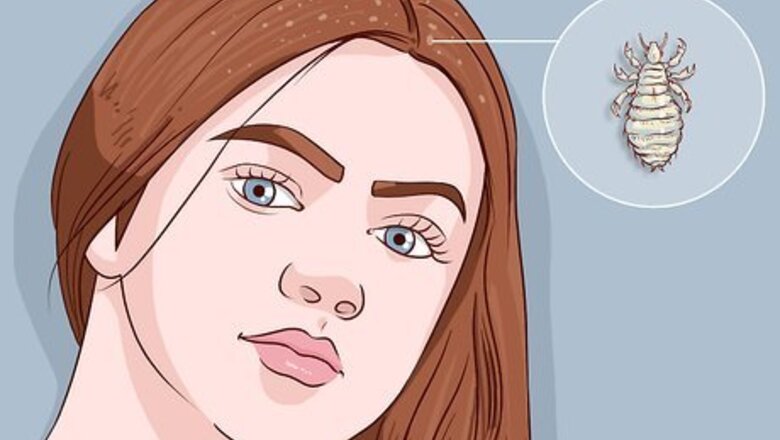
views
Killing Adult Head Lice

Exterminate all adult lice. Removing the nits from the hair of the person affected won't make a difference if adult lice are still able to breed. As long as there are adult lice, new batches of eggs will continue to appear on the hair. These additional eggs will then hatch into more lice, which in turn will lay more eggs. This unending cycle is not broken until all adult lice have been killed. Submerging your hair underwater for an extended period of time will not kill or drown lice. Studies show that the lice simply cling to the hair or scalp while underwater and can survive underwater for several hours. The chlorine in pool water, unfortunately, is also not strong enough to kill lice. To kill adult lice, wash your hair, or that of the person affected, with over-the-counter lice shampoo. In extreme cases of head lice, prescription-strength head lice shampoo is also available.
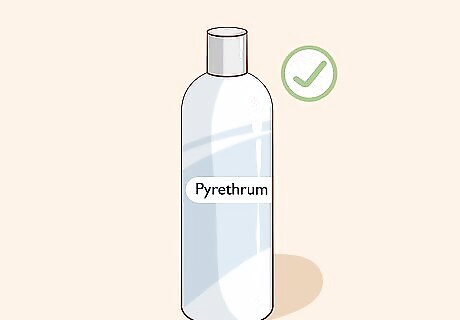
Try a prescription shampoo. One option is Pyrethrum, which comes from chrysanthemum flowers that harbor natural insecticides called pyrethrins. Pyrethrins attack lice’s nervous systems, though some lice are now resistant to the toxin. Apply the shampoo to dry hair. Then, wait ten minutes, add water, work into a lather, and rinse. You should then try to remove nits and repeat the process seven to 10 days later, to kill any remaining bugs.
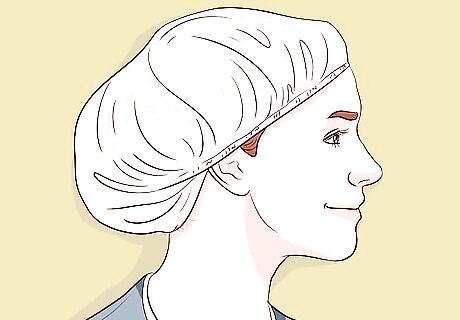
Suffocate the live lice as an alternative. Although there are few clinical studies on its effectiveness, some people believe that you can kill lice by suffocation. The way this works is that certain products, they argue, clog the bugs’ breathing holes. Lice can survive for hours without breathing, but eventually they will die. Try a petroleum jelly like Vaseline. Apply the jelly to your hair and scalp thickly. The jelly must remain for up to eight hours to kill, and you should wear a shower cap to restrict air flow. Keep in mind that Vaseline will be very hard to remove and will not kill the nits. Some people also advocate the use of common olive oil. Again, some claim that the oil plugs the insects’ breathing holes and suffocates them. Like Vaseline, you should apply the oil to your hair and scalp, don a shower cap, and wait about eight hours before cleaning the oil. As a bonus, the oil should loosen the nits from your hair and make it easier to remove them. Mayonnaise may work as well. Mayo contains a large amount of oil, which seems to be the suffocating ingredient. Apply to your hair and scalp like Vaseline and olive oil. Anecdotal evidence suggests that regular, high fat mayonnaise works best.
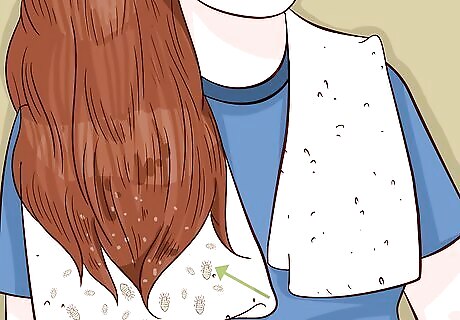
Prepare your nit-removal area. Sit down in an area with plenty of natural or artificial light. This will make it easier the person removing the nits to actually see them, as they are small and are glued to the hair near the scalp. Additionally, drape a towel over your shoulders to catch any hair or nits that fall off.
Removing Nits with Vinegar
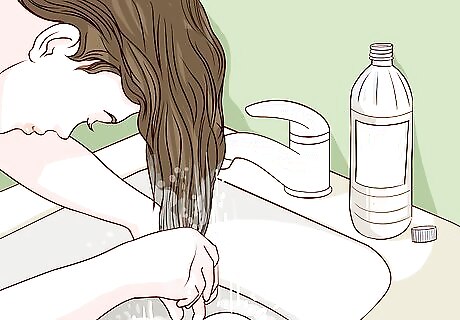
Rinse your hair with water and vinegar. Nit eggs are covered in a sticky substance which binds them to human hair follicles. Vinegar has been found to contain chemicals that dissolve this substance, preventing nits from maintaining their grip on human hair. While kneeling in front of a bathtub, place your head under the faucet. Turn on the warm water and thoroughly dampen your hair. Then, turn off the water and, while still kneeling, pour a large amount of vinegar over your head. Make sure that all strands are coated with the liquid. Then use warm water to rinse your hair. Alternatively, fill a sink with 1:1 parts of water and vinegar. Submerge your hair in the sink entirely, either by dipping your head forward or dipping it backward into the solution. Detangle with a leave-in conditioner and normal brush. Try to get your hair entirely detangled, so that combing with a nit brush is easy and painless.
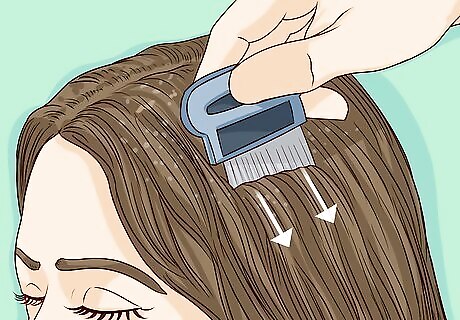
Begin to comb out the nits. If you are the one affected by lice, then you will need the help of another person. They'll need a metal nit comb — a fine-toothed and rigid comb that is better at removing nits than a plastic comb. You should be able to buy a nit comb at most pharmacies for under $10. They can use a magnifying lens if possible to search for hard-to-see nits. A large number of nits could have been rinsed out of your hair during the vinegar application. However, there will likely still be eggs clinging to the dampened strands. Working with one small section of hair at a time — about the width of the nit comb — your helper should carefully comb through your entire head.
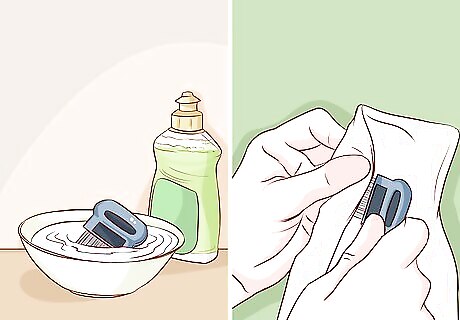
Rinse the nit comb after each section. Once the comb has run-through a section of hair, the comb should be cleaned off in a shallow bowl filled with water and dish soap. Then, wipe it dry using facial tissue or paper towel, being sure to remove any lice or nits that have clung to the comb.

Repeat this process until you have combed through all of your hair. Once your helper has finished with a particular portion of hair, he should pin it flat to the side of your head to minimize the chance of re-infestation.
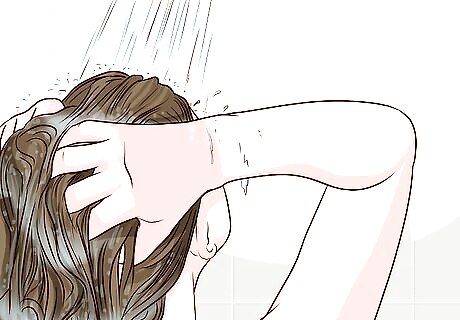
Wash your hair. You may want to wash your hair one more time after a complete comb-through. Even if all the nits and live lice have been removed by this point, a final wash may help you to feel cleaner. Consider using the head lice shampoo again to ensure complete removal of all living nits and their eggs. Once your hair is dry, examine it carefully for signs of lice or nits. If you can see any of these creatures, start the removal process over from the beginning.
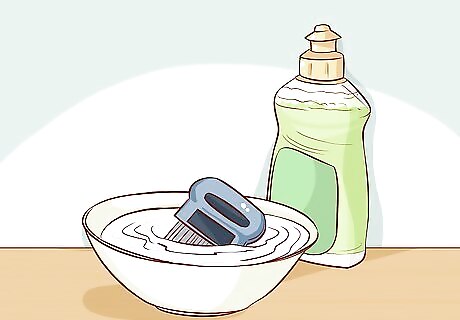
Clean your materials. Put the soapy nit bowl in the dishwasher or leave it full of just-boiled water for 10 minutes with a lid on it. You can also stand hairbrushes, hairclips, etc., in a container with just-boiled water, along with the louse comb but try to remove all hair and eggs from them first. Heat over 129°F (54 °C) will kill lice and nits after five to 10 minutes. Alternatively, combine two cups of just-boiled water with one cup of ammonia. Soak the nit comb in the ammonia water for 15 minutes, and then clean the comb with an old toothbrush. Each family member should have his own comb. Eliminate recurring nits through comprehensive tactics. "My daughters kept getting reinfested with nits from school and siblings. I was so frustrated. This article outlined all-encompassing strategies beyond just shampoos — from suffocating adult lice to disinfecting brushes and bedding. After trying every thorough tip, we finally have no more nits!" - Karis W. Remove clingy nits easily with vinegar. "I could never get all the tiny nits off my kids' hair strands. The shampoos hardly helped. But the tip to rinse hair with equal parts vinegar and water made a huge difference. The vinegar dissolved the sticky glue binding the eggs. Then they combed right out with a nit comb!" - Diane G. Achieve nit-free results through diligent combing. "As a child, I always had nits reappear. But this article stressed carefully combing out every section of hair with a quality nit comb. My mom took her time going strand by strand. Being so diligent, I finally removed every last egg. I've been nit-free ever since!" - Denny M. Prevent reinfestation by disinfecting accessories. "The best tips were soaking combs, brushes, and hair accessories in very hot water. Doing this for all my kids' items killed any stray nits lingering on them. We haven't had a reoccurrence since disinfecting everything thoroughly." - Yashita J. Did you know that wikiHow has collected over 365,000 reader stories since it started in 2005? We’d love to hear from you! Share your story here.
Removing Nits with Listerine
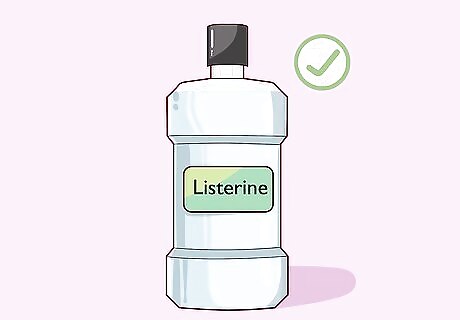
Saturate the hair with Listerine. Listerine or a similar mouthwash contains a high percentage of alcohol that will kill live lice and dissolve the nits’ binding to the hair follicle. While some “natural remedy” websites suggest it, be warned that other medical websites do not recommend its use. For one thing, Listerine’s alcohol content can burn the eyes and sting if it comes into contact with open wounds. It could also be accidentally consumed by a child. If you decide to use Listerine, use it to wet the hair completely and cover with a shower cap for 30 minutes or longer. This will kill the adult lice. Repeat if needed. You can also put the Listerine on your hair and put a towel on your pillow, to keep it from getting wet, and go to sleep and do the remaining steps in the morning.
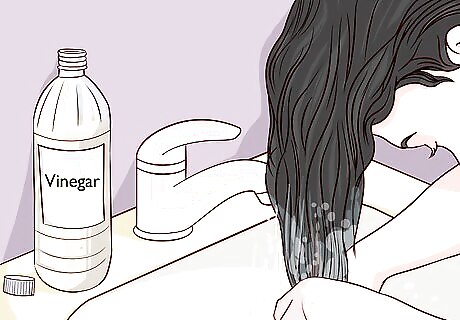
Rinse with warm water and vinegar. After soaking your hair, flush the Listerine out thoroughly with warm water and apply a generous amount of vinegar to further loosen the nits. Following the above steps, apply a leave-in conditioner or de-tangler, brush the hair, and then use a nit comb to slowly remove the eggs section by section.
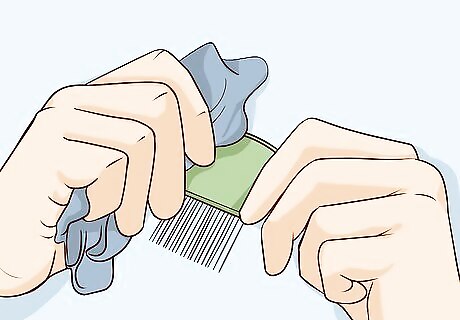
Clean up your worksite and materials. Clean the nit comb in a dish of soapy water or in the heat of a dishwasher. Also put the Listerine into a spray bottle and spray your nearby furniture. This will kill the adults and help to prevent re-infestation. You can wash any linens, towels, or bedding in hot water. Remember that sustained heat will kill lice and nits.
Preventing a Re-infestation

Avoid head-to-head contact with others. Thankfully, head lice are not very mobile. They cannot jump and cannot survive for long off of a human head. The most common way that they spread is through direct head-to-head contact. This might take place at school, while playing sports, or during sleepovers for children. For adults, it might be through contact with an infested loved one.
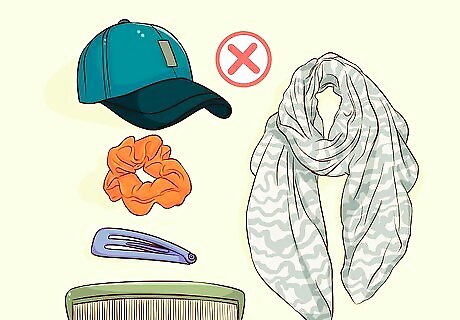
Avoid contact with infested clothing accessories, personal cleaning products, and bedding. Lice cannot feed if they are not on a human head and will starve to death in one to two days. But it still helps to be cautious. Avoid objects that could harbor live lice or their eggs. This includes hats, hair ties, barrettes, scarves, coats, and uniforms. Do not share these objects, either, or combs, brushes, and towels. Soak all combs, brushes, and towels in water hotter than 130°F (54°C) for 10 minutes in order to disinfect.
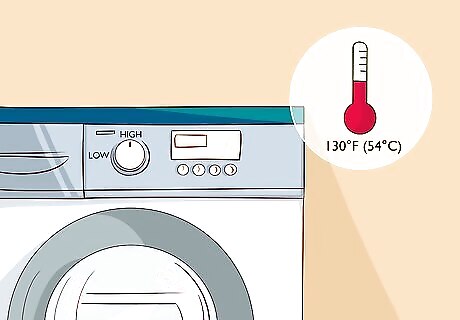
Wash all clothes, towels, and linens in high heat. Used bedding, pillows, stuffed animals, or towels can be laundered in hot water and dried on high heat to effectively kill the insects. Again, make sure that the water is hotter than 130°F (54°C). If clothes cannot be washed or dried using high heat, take them to the dry cleaner or seal them in a plastic bag for two weeks.
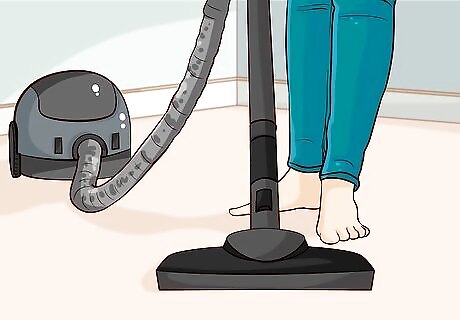
Vacuum the floor and other surfaces. You or another infested person may have dropped live lice or eggs on surfaces in your home, like the couches or carpets. If possible, use a vacuum with a HEPA filter to ensure that any nits are absorbed during the vacuum process. Lice or nits on such surfaces will not be viable for long and probably won’t spread. Still, it is a good precaution to clean them up as soon as possible.
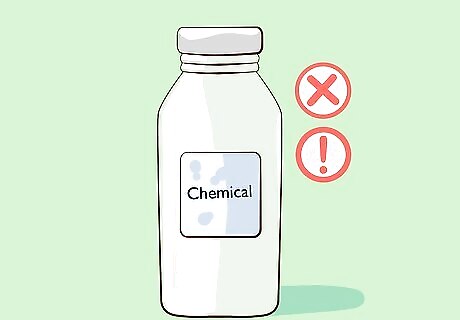
Be wary of harsh chemicals. Fumigants and other harsh chemicals are not necessary to eradicate fleas and nits. The potential danger of inhaling or coming into contact with a strong chemical may be worse than the upside. Even if chemical remedies are available, be aware that overuse in the past few decades has caused their effectiveness to decline. The insects have in many cases built up an immunity to them.



















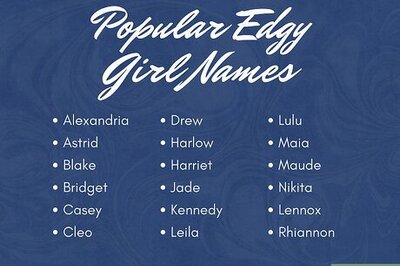
Comments
0 comment